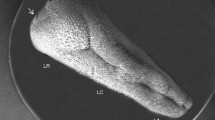Summary
Epithelial lesions in the nasal cavity of male F344 rats appeared as papillary and nodular hyperplasias progressing to invasive carcinomas during administration of 1,4-dinitrosopepirazine (DNP) at a dose of 0.01% in the drinking water. Observations with specific attention to the cells covering the luminal surface of the mucosa were made by scanning electron microscopy at 10-week intervals. After administration of DNP for 20 and 30 weeks three different types of light microscopically identifiable focal lesions, i.e., papillary hyperplasia, nodular hyperplasia and papilloma, of the epithelium in the nasal cavity were distinguished, and after 40 and 50 weeks areas of squamous cell carcinomas were also observed. In the scanning electron microscope, papillary hyperplasia appeared as a nodular elevation of the surface with a smoother appearance than the surrounding nonnodular areas. Areas of nodular (inverted) hyperplasias had irregularly shaped indentions of the surface. Papillomas appeared as pedunculated projections of the surface. Carcinoma presented as a protrusion of irregular cell masses. The surface cells in the areas of papillary and nodular hyperplasias and of papilloma had numerous short microvilli rather uniform in shape (short-uniform microvilli), unlike the normal epithelium in the nasal cavity, which possesses cilia or olfactory vesicles. The microvilli of carcinoma cells were more irregular in shape and size than those of hyperplastic cells (pleomorphic microvilli).
Similar content being viewed by others
References
Arai M, Kani T, Sugihara S, Matsumura K, Miyata Y, Shinohara Y, Ito N (1974) Scanning and transmission electron microscopy of changes in the bladder in rats treated with N-butyl-N-(4-hydroxybutyl)nitrosamine. Gann 65:529–540
Fukushima S, Arai M, Cohen SM, Jacobs JB, Friedell GH (1981) Scanning electron microscopy of cyclophosphamide-induced hyperplasia of the rat urinary bladder. Lab Invest 44:89–96
Li**sky W, Taylor HW (1975) Carcinogenicity of methylated dinitrosopiperazines in rats. Cancer Res 35:1270–1273
Lupulescu A, Boyd CB (1972) Lung cancer: A transmission and scanning electron microscopic study. Cancer 29:1530–1538
Port CD, Henry MC, Kaufmann DG, Harris CC, Ketels KV (1973) Acute changes in the surface morphology of hamster tracheobronchial epithelium following benzo(a)pyrene and ferric oxide administration. Cancer Res 33:2494–2506
Pour P, Cardesa A, Althoff J, Mohr U (1974) Tumorigenesis in the nasal olfactory region of Syrian golden hamsters as a result of di-n-propylnitrosamine and related compounds. Cancer Res 34:16–26
Reznik G, Reznik-Schüller H, Ward JM, Stinson SF (1980) Morphology of nasal cavity tumors in rats after chronic inhalation of 1,2-dibromo-3-dibromo-3-chloropropane. Br J Cancer 42:772–781
Shirai T, Murasaki G, Tatematsu M, Tsuda H, Fukushima S, Ito N (1977) Early surface changes of the urinary bladder epithelium of different animal species induced by N-butyl-N-(4-hydroxybutyl)nitrosamine. Gann 68:203–212
Stenbec F (1973) Glandular tumors of the nasal cavity induced by diethylnitrosamine in Syrian golden hamsters. J Natl Cancer Inst 50:895–901
Swenberg JA, Kerns WD, Mitchel RI, Gralla EJ, Pavkov KL (1980) Induction of squamous cell carcinoma of rat nasal cavity by inhalation exposure to formaldehyde vapor. Cancer Res 40:3398–3402
Takano T, Shirai T, Ogiso T, Tsuda H, Baba S, Ito N (1982) Sequential changes in tumor development in the nasal cavity induced by 1,4-dinitrosopiperazine in F344 rats. Cancer Res 42:4236–4240
Author information
Authors and Affiliations
Additional information
Supported in part by Grants-in-Aid for Cancer Research from the Ministry of Education, Science and Culture of Japan, the Ministry of Health and Welfare of Japan
Rights and permissions
About this article
Cite this article
Tsuda, H., Takano, T., Shirai, T. et al. Comparative light and scanning electron microscopic observations of nasal cavity carcinogenesis in rats treated with 1,4-dinitrosopiperazine. J Cancer Res Clin Oncol 108, 186–191 (1984). https://doi.org/10.1007/BF00402465
Received:
Accepted:
Issue Date:
DOI: https://doi.org/10.1007/BF00402465




